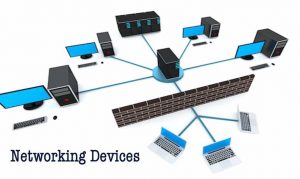Different networking devices have different roles to play in a computer network. These network devices also work at different segments of a computer network performing different works. In our new series after network topology, we talk about different networking devices like a switch, router, hub, bridge etc.

Computer networking devices are known by different names such as networking devices, networking hardware, network equipment etc. However, all of the names mean the same but have got different purposes. After covering different topics on network topologies and their advantages and disadvantages, we are here once again with a series on the network devices.
Before we talk more about the networking devices, here are a few topics you might want to take a look at that we covered under network topology section:
- Daisy chaining in computer networks
- Different network Topologies
- Tree Topology
- Mesh Topology
- Star Topology
- Ring Topology
- Bus Topology
If we take a look at the different devices, they work at different layers of the computer networks. Different layers of a computer network are like different zones of a computer network with specified works, also called as ‘network protocols’.
For example:
A LAN cable has got the purpose of connecting a computer to the local area network, a Wi-Fi router has got the purpose of sending and receiving data between you and your internet connection. Similarly, we can think of other network devices with different purposes to serve.
Different networking devices:
Network Hub:
Network Hub is a networking device which is used to connect multiple network hosts. A network hub is also used to do data transfer. The data is transferred in terms of packets on a computer network. So when a host sends a data packet to a network hub, the hub copies the data packet to all of its ports connected to. Like this, all the ports know about the data and the port for whom the packet is intended, claims the packet.
However, because of its working mechanism, a hub is not so secure and safe. Moreover, copying the data packets on all the interfaces or ports makes it slower and more congested which led to the use of network switch.
Network Switch:
Like a hub, a switch also works at the layer of LAN (Local Area Network) but you can say that a switch is more intelligent than a hub. While hub just does the work of data forwarding, a switch does ‘filter and forwarding’ which is a more intelligent way of dealing with the data packets.
So, when a packet is received at one of the interfaces of the switch, it filters the packet and sends only to the interface of the intended receiver. For this purpose, a switch also maintains a CAM (Content Addressable Memory) table and has its own system configuration and memory. CAM table is also called as forwarding table or forwarding information base (FIB).
Modem:
A Modem is somewhat a more interesting network device in our daily life. So if you have noticed around, you get an internet connection through a wire (there are different types of wires) to your house. This wire is used to carry our internet data outside to the internet world.
However, our computer generates binary data or digital data in forms of 1s and 0s and on the other hand, a wire carries an analog signal and that’s where a modem comes in.
A modem stands for (Modulator+Demodulator). That means it modulates and demodulates the signal between the digital data of a computer and the analogue signal of a telephone line.
Network Router:
A router is a network device which is responsible for routing traffic from one to another network. These two networks could be a private company network to a public network. You can think of a router as a traffic police who directs different network traffic to different directions.
Bridge:
If a router connects two different types of networks, then a bridge connects two sub-networks as a part of the same network. You can think of two different labs or two different floors connected by a bridge.
Repeater:
A repeater is an electronic device that amplifies the signal it receives. In other terms, you can think of repeater as a device which receives a signal and retransmits it at a higher level or higher power so that the signal can cover longer distances.
For example, inside a college campus, the hostels might be far away from the main college where the ISP line comes in. If the college authority wants to pull a wire in between the hostels and main campus, they will have to use repeaters if the distance is much because different types of cables have limitations in terms of the distances they can carry the data for.
When these network devices take a particular configurational shape on a network, their configuration gets a particular name and the whole formation is called Network topology. In certain circumstances when we add some more network devices to a network topology, its called Daisy chaining.
Did you find this article helpful? Give your feedback in the comments section below.
 Follow
Follow